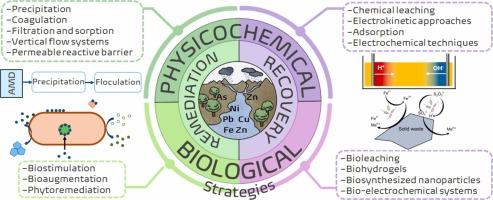From waste to resource: A review on biological and physicochemical metal remediation and recovery in the light of the circular economy
IF 11.3
1区 环境科学与生态学
Q1 ENGINEERING, ENVIRONMENTAL
引用次数: 0
Abstract
Remediating metal-contaminated sites, particularly those impacted by the extraction or processing of critical raw materials (CRMs), poses significant environmental and health challenges. This topic has typically been approached from either a physicochemical or a biological perspective, depending on the disciplinary focus. The present review seeks to bridge that gap by integrating both approaches into a unified and comprehensive framework, exploring their interconnections and highlighting the insights that emerge from their synthesis. It describes current advances in both methods groups for the treatment of metal-containing wastes, focusing on the removal of toxic metal(loid)s, and the recovery of CRMs within the framework of the circular economy. Physicochemical techniques play a crucial role in waste decontamination, while biological methods may offer environmentally sustainable alternatives for mitigating metal pollution. Microbial strategies are particularly advantageous due to their high specificity and effectiveness even at low contaminant concentrations, while also facilitating site restoration with minimal ecological damage. Integrating biological and physicochemical treatments may significantly enhance remediation performance, for more efficient and sustainable solutions. In particular, “treatment trains” or sequential treatment approaches combine multiple remediation methods to enhance efficiency while enabling recovery and reuse of valuable metals. Successful implementation of these strategies requires the optimization of treatment conditions and the integration of green remediation practices into large-scale applications. This review highlights the need for more comprehensive and in-depth studies (including field-scale applications) to address critical knowledge gaps and to further develop these potentially cost-effective and more sustainable methods for extracting valuable metals from mining waste.

从废物到资源:循环经济背景下金属的生物与物理化学修复与回收研究进展
修复受金属污染的场地,特别是那些受到关键原材料提取或加工影响的场地,构成了重大的环境和健康挑战。这个主题通常是从物理化学或生物学的角度来处理的,这取决于学科的重点。本审查力求将这两种方法纳入一个统一和全面的框架,探讨它们的相互联系,并突出从它们的综合中产生的见解,从而弥合这一差距。它描述了处理含金属废物的两种方法组的当前进展,重点是去除有毒金属(loid),以及在循环经济框架内回收crm。物理化学技术在废物净化中起着至关重要的作用,而生物方法可能为减轻金属污染提供环境上可持续的替代方法。微生物策略尤其有利,因为即使在低污染物浓度下,它们也具有高特异性和有效性,同时还有助于以最小的生态破坏进行场地恢复。结合生物和物理化学处理可以显著提高修复性能,以获得更有效和可持续的解决方案。特别是,“处理序列”或顺序处理方法结合了多种修复方法,以提高效率,同时实现有价金属的回收和再利用。这些策略的成功实施需要优化处理条件并将绿色修复实践整合到大规模应用中。这一审查强调需要进行更全面和深入的研究(包括实地规模的应用),以解决关键的知识差距,并进一步发展这些可能具有成本效益和更可持续的方法,从采矿废料中提取有价值的金属。
本文章由计算机程序翻译,如有差异,请以英文原文为准。
求助全文
约1分钟内获得全文
求助全文
来源期刊

Journal of Hazardous Materials
工程技术-工程:环境
CiteScore
25.40
自引率
5.90%
发文量
3059
审稿时长
58 days
期刊介绍:
The Journal of Hazardous Materials serves as a global platform for promoting cutting-edge research in the field of Environmental Science and Engineering. Our publication features a wide range of articles, including full-length research papers, review articles, and perspectives, with the aim of enhancing our understanding of the dangers and risks associated with various materials concerning public health and the environment. It is important to note that the term "environmental contaminants" refers specifically to substances that pose hazardous effects through contamination, while excluding those that do not have such impacts on the environment or human health. Moreover, we emphasize the distinction between wastes and hazardous materials in order to provide further clarity on the scope of the journal. We have a keen interest in exploring specific compounds and microbial agents that have adverse effects on the environment.
 求助内容:
求助内容: 应助结果提醒方式:
应助结果提醒方式:


